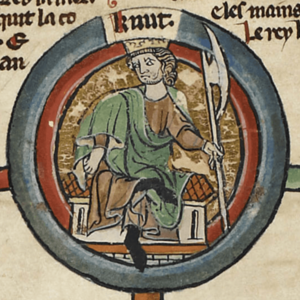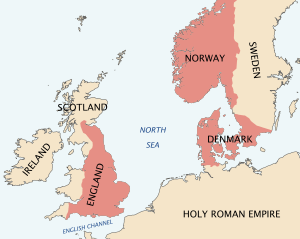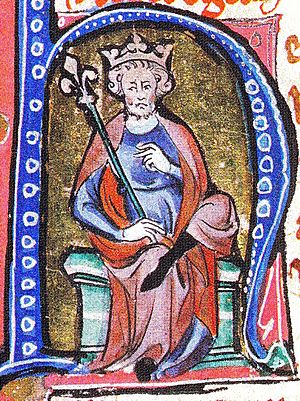Cnut facts for kids
Quick facts for kids Cnut |
|
|---|---|
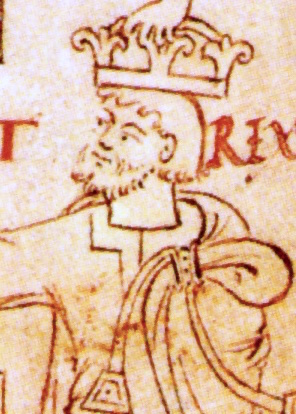
Contemporary portrait of King Cnut
from the New Minster Liber Vitae, 1031 |
|
| King of England | |
| Reign | 1016–1035 |
| Coronation | 1017 in London |
| Predecessor | Edmund II |
| Successor | Harold I |
| King of Denmark | |
| Reign | 1018–1035 |
| Predecessor | Harald II |
| Successor | Harthacnut |
| King of Norway | |
| Reign | 1028–1035 |
| Predecessor | St Olaf II |
| Successor | Magnus the Good |
| Co-King | Svein Knutsson |
| Born | c. 990 Denmark |
| Died | 12 November 1035 (aged around 45) Shaftesbury, Dorset, England |
| Burial | Old Minster, Winchester, England. Bones now in Winchester Cathedral, Winchester, England. |
| Spouse | |
| Issue | |
| House | Jelling |
| Father | Sweyn Forkbeard |
Cnut (died 12 November 1035), also known as Cnut the Great or Canute, was a powerful Viking king. He ruled over a vast empire called the North Sea Empire. This empire included England, Denmark, and Norway. He was King of England from 1016, King of Denmark from 1018, and King of Norway from 1028.
Cnut started as a Danish prince. He became King of England in 1016 after many years of Viking raids. When he also became King of Denmark in 1018, he brought the two crowns together. Cnut wanted to unite the Danes and English. He worked to create a strong kingdom. After fighting in Scandinavia, Cnut also became King of Norway in 1028.
His control over England was very important. It gave the Danes a strong link to the seas around Great Britain and Ireland. Cnut also gained respect from the Catholic Church. He even got special agreements for his bishops and for travelers going to Rome. Cnut called himself "King of all England and Denmark and the Norwegians and of some of the Swedes." Many historians see him as one of the most effective kings in Anglo-Saxon history.
Contents
- Cnut's Early Life and Rise to Power
- How Cnut Conquered England
- Cnut as King of England
- Cnut as King of Denmark
- Cnut as King of Norway and Part of Sweden
- Cnut's Influence in the Western Seas
- Cnut's Relationship with the Church
- Cnut's Death and What Happened Next
- Cnut's Family
- Family Tree
- Cnut's Poets
- The Story of Cnut and the Waves
- See also
Cnut's Early Life and Rise to Power
Cnut was the son of Sweyn Forkbeard, a Danish prince. Sweyn was the son of King Harald Bluetooth. This means Cnut came from a long line of important Scandinavian rulers. We don't know exactly when or where Cnut was born.
Cnut's grandfather, Harald Bluetooth, was one of the first Scandinavian kings to become Christian. This was important for Cnut's future rule.
Who Was Cnut's Mother?
Historians have different ideas about Cnut's mother. Some old texts say she was a Polish princess named Świętosława. Other Norse stories call her Gunhild. It's a bit confusing, but it's clear she was an important figure from a powerful family.
Cnut's First Battles
We don't know much about Cnut's childhood. Some stories say he learned to be a soldier from a chieftain named Thorkell the Tall. Cnut was quite young when he first went to war. He might have joined his father, Sweyn Forkbeard, in England around 1003 or 1004.
In 1013, Cnut was part of a big Scandinavian army that invaded England. His father, King Sweyn, quickly took control of the country. King Æthelred the Unready fled to Normandy. Sweyn became King of England, with Cnut in charge of the fleet.
However, Sweyn died just a few months later in 1014. The Vikings in England chose Cnut as their new king. But the English nobles wanted Æthelred back. Æthelred returned and forced Cnut to flee back to Denmark. Cnut then gathered a large fleet to invade England again.
How Cnut Conquered England

Cnut had strong allies for his invasion. The Duke of Poland, Bolesław I the Brave, who was related to the Danish royal family, sent Polish troops. Swedes were also among Cnut's allies. Eiríkr Hákonarson, a Norwegian earl, also joined Cnut.
In the summer of 1015, Cnut's fleet sailed to England. He had about 10,000 Danish soldiers on 200 longships. This army was made up of Vikings from all over Scandinavia. They fought fiercely against the English for over a year. Most of the battles were against King Æthelred's eldest son, Edmund Ironside.
Landing in Wessex
Cnut's army landed in Sandwich and sailed around Kent. They then attacked Dorset, Wiltshire, and Somerset. The region of Wessex, which had been ruled by English kings for a long time, soon surrendered to Cnut. Some English leaders, like Eadric Streona, even joined Cnut's side.
Fighting for Control of England
In early 1016, Cnut's Vikings crossed the River Thames and attacked Warwickshire. King Æthelred's army struggled to fight back. Cnut's army moved north, causing a lot of damage. Prince Edmund went north to join forces with Uhtred the Bold, the Earl of Northumbria. But Uhtred later submitted to Cnut.
King Æthelred died on April 23, 1016. Prince Edmund was then chosen as the new king.
The Siege of London

Cnut's army returned south and surrounded London. They built dikes and dug a channel to block the River Thames, cutting off the city.
Edmund managed to escape London and gather an army in Wessex. There were several battles, but neither side won a clear victory at first. Edmund temporarily freed London, but the Danes soon besieged it again.
England Divided by Treaty
On October 18, 1016, Cnut's army fought Edmund's army at the Battle of Assandun in Essex. During the battle, Eadric Streona, who had rejoined Edmund, pulled his troops away. This led to a major defeat for the English. Edmund fled west, and Cnut followed him.
Cnut and Edmund met on an island near Deerhurst to make peace. They agreed to divide England. Cnut would rule all lands north of the Thames. Edmund would keep the south, including London. It was also agreed that Cnut would become king of all England when Edmund died.
Edmund died just weeks later, on November 30. The people of Wessex then accepted Cnut as king of all England. Cnut was crowned in London in 1017.
Cnut as King of England
Cnut ruled England for almost 20 years. He brought peace and stability after many years of Viking raids. This helped England become prosperous again. In return, England helped Cnut gain control over much of Scandinavia. During his rule, England did not face serious attacks from outside.
Making His Rule Strong
As King of England, Cnut quickly removed anyone who might challenge him. He executed some English noblemen he didn't trust. The sons of former King Æthelred fled to Normandy for safety.
In July 1017, Cnut married Queen Emma, who was the widow of King Æthelred. This marriage helped connect him to the old English royal family. In 1018, Cnut collected a huge tax called the Danegeld. With this money, he paid off his army and sent most of them home. He kept 40 ships and their crews as a permanent force in England.
Cnut divided England into four large areas called earldoms. These were Wessex, Northumbria, East Anglia, and Mercia. He put powerful men, both Danes and English, in charge of these areas. Over time, Cnut trusted more English nobles to rule his earldoms.
His Laws and Coins
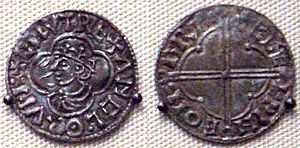
Cnut was known as a wise and successful king. He treated the Church well, which helped his image in history. He brought together the English and Danish kingdoms. His rule meant that Viking power shifted towards Scandinavia.
Cnut brought back old English laws. He also made new laws to help people. He made the currency stronger by creating coins that had the same weight as those used in Denmark. He had both English and Scandinavian people in his royal court.
Cnut as King of Denmark
When his brother Harald II died in 1018, Cnut went to Denmark. He became the new King of Denmark. He wrote a letter to England in 1019, promising to protect England from attacks.
Cnut appointed Ulf Jarl, his brother-in-law, to rule Denmark for him. Ulf also looked after Cnut's young son, Harthacnut, who was meant to inherit the Danish kingdom.
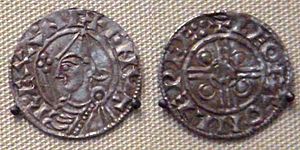
The Norwegian king Olaf Haraldsson and the Swedish king Anund Jacob started attacking Denmark. Ulf Jarl tried to make Harthacnut king, which was a trick to gain power himself. When Cnut heard this, he sailed to Denmark. He put things right and dealt with Ulf.
Cnut and his men fought the Norwegians and Swedes at the Battle of Helgeå around 1026. Cnut won, becoming the most powerful leader in Scandinavia. Ulf Jarl, despite fighting in the battle, did not earn Cnut's forgiveness. Some stories say Cnut had Ulf killed on Christmas Day in 1026.
Journey to Rome
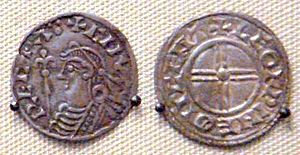
With his enemies in Scandinavia under control, Cnut traveled to Rome in 1027. He went to witness the crowning of the Holy Roman Emperor Conrad II. This trip was very important for a European ruler in the Middle Ages.
Cnut wrote a letter to his people in England from Rome. He said he went to Rome to ask for forgiveness for his sins. He also wanted to get better deals from the Pope. He asked for lower fees for English archbishops and for pilgrims and merchants to be safe on their way to Rome.
Cnut's visit to Rome was a great success. He was seen as a just Christian king and a skilled diplomat. He even stood shoulder-to-shoulder with the Emperor Conrad II. Conrad gave Cnut land in Schleswig, which was a bridge between Scandinavia and Europe. This showed their strong friendship.
Cnut as King of Norway and Part of Sweden
In his 1027 letter, Cnut called himself king of "the Norwegians, and of some of the Swedes." This shows his victory over the Swedes. In 1028, Cnut sailed from England to Norway with 50 ships. King Olaf Haraldsson could not fight back because many of his nobles had been bribed by Cnut.
Cnut was crowned King of England, Denmark, Norway, and part of Sweden. He put Haakon Eiriksson, a relative, in charge of Norway. However, Haakon drowned in a shipwreck in 1029 or 1030.
After Haakon's death, Olaf Haraldsson returned to Norway. But he was killed by his own people in the Battle of Stiklestad in 1030. Cnut tried to rule Norway through his first wife, Ælfgifu of Northampton, and their son, Svein Knutsson. But this was not successful. The Norwegians rebelled, and Olaf's son, Magnus the Good, later became king.
Cnut's Influence in the Western Seas
Cnut had a lot of influence over the Viking settlements in the Irish Sea area. Coins made in Dublin during his time sometimes had Cnut's name on them. This shows his power in the region.
Around 1031, Cnut went to Scotland with his army and navy. Three Scottish kings, including Malcolm II of Scotland and the future King Macbeth, submitted to him without a fight. However, Cnut's influence over Scotland did not last long after his death.
Cnut's Relationship with the Church

Cnut was a Christian, but his actions as a conqueror made the Church uneasy. He was married to two women, which was against Church teachings. To make peace with the Church, Cnut repaired many English churches and monasteries that Vikings had damaged. He also built new churches and supported religious communities.
It's hard to know if Cnut was truly religious or if he just used the Church to strengthen his rule. He allowed his poets to use references to old Norse gods in their poems. But he also wanted his kingdom to be seen as a respected Christian nation in Europe.
Cnut gave many gifts to churches and monasteries. He gave land, tax exemptions, and holy relics. For example, he gave important rights to Canterbury Cathedral. He also gave valuable gifts to churches in Europe, like a psalter to Cologne. His journey to Rome in 1027 also showed his dedication to Christianity.
Cnut's Death and What Happened Next
Cnut died on November 12, 1035, in Shaftesbury, England. He was buried in the Old Minster, Winchester.
In Denmark, Cnut was succeeded by his son Harthacnut. But Harthacnut was busy fighting in Scandinavia. So, Cnut's other son, Harold Harefoot, became regent in England. Harold later claimed the English throne in 1037 and ruled until his death in 1040.
Harthacnut eventually came to England in 1040 and became king, bringing the crowns of Denmark and England together again. He died in 1042. After his death, the English throne went back to the old Anglo-Saxon royal family. Edward the Confessor, Cnut's stepson, became king.
If Cnut's sons had lived longer, his reign might have led to a lasting political union between England and Scandinavia. This could have created a powerful North Sea Empire.
Cnut's Bones in Winchester
Cnut's bones are now in Winchester Cathedral. During the English Civil War in the 17th century, soldiers scattered the bones. Later, they were collected and put back into chests, but they got mixed up with the bones of other kings.
Cnut's Family
- With Ælfgifu of Northampton:
- Svein Knutsson, King of Norway
- Harold Harefoot, King of England
- With Emma of Normandy:
- Harthacnut, King of Denmark and England
- Gunhilda of Denmark, who married Henry III, Holy Roman Emperor.
Family Tree
|
|||||||||||||||||||||||||||||||||||||||||||||||||||||||||||||||||||||||||||||||||||||||||||||||||||||||||||||||||||||||||||||||||||||||||||||||||||||||||||||||||||||||||||||||||||||||||||||||||||||||||||||||||||||||||||||||||||||||||||||||||||||||||||||||||||||||||||||||||||||||||||||||||||||||||||||||||||||||||||||||||||||||||||||||||||||||||||||||||||||||||||||||||||||||||||||||||||||||||||||||||||||||||||||||||||||||||||||||||||||||||||||||||||||||||||||||||||||||||||||||||||||||||||||||||||||||||||||||||||||||||||||||||||||||||||||||||||||||||||||||||||||||||||||||||||||||||||||||||||||||||||||||||||||||||||||||||||||||||||||||||||||||||||||||||||||||||||||||||||||||||||||||||||||||||||||||||||||||||||||||||||||||||||||||||||||||||||||||||||||||||||||||||||||||||||||||||||||||||||||||||||||||||||||||||||||||||||||||||||||||||||||||||||||||||||||||||||||||||||||||||||||||||||||||||||||||||||||||||||||||||||||||||||||||||||||||||||||||||||||||||||||||||||||||||||||||||||||||||||||||
Cnut's Poets
Cnut had several poets, called skalds, at his court. These poets wrote verses praising Cnut. They often compared Cnut's rule on Earth to God's rule in Heaven. For example, one poem says, "Cnut protects the land as the guardian of Byzantium [God] [does] Heaven."
These poets sometimes used old pagan references from Norse mythology. Cnut seemed to be okay with this, even though he was a Christian king.
The Story of Cnut and the Waves
This is the most famous story about Cnut. In the story, Cnut shows his courtiers that even a king cannot control the ocean waves. He orders the tide to stop, but it keeps coming in. This shows that Cnut was a wise man who understood that some things are beyond a king's power.
See also
 In Spanish: Canuto II de Dinamarca para niños
In Spanish: Canuto II de Dinamarca para niños
- North Sea Empire
- Raven banner
- Viking Age


